Inside America's Aladdin's cave of dead animals
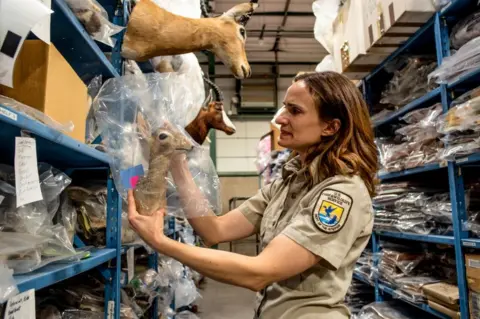 BBC
BBCJust outside Denver a huge warehouse holds a strange assortment of objects - among them are stuffed tigers, elephant trunks and pangolin cowboy boots. This is the front line in the fight against a deadly global trade.
In an unassuming building hidden amidst the Rocky Mountains in Colorado is a treasure trove of dead animals.
The US Fish and Wildlife Service is a key player in the fight against global wildlife trafficking and this place - the National Wildlife Property Repository - is an important and unique hub for conservation specialists.
It is the place where many of the illegal wildlife products seized by law enforcers at US ports and during criminal investigations end up.
There are more than 1.2 million items ranging from stuffed tigers, elephant trunk lamps, thousands of bear claws, medicinal goods to pangolin leather cowboy boots meticulously stored and categorised in the 22,000 sq ft warehouse.
This is an Aladdin's cave of death.
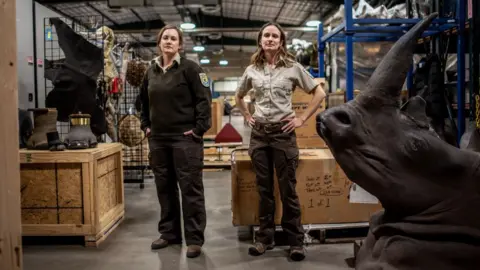 BBC
BBC
It is not just animals that the repository collects but also rare plants and items made out of trees - many of which are covered by the Convention on International Trade in Endangered Species of Wild Flora and Fauna (CITES).
But for Sarah Metzer, an education specialist who has worked at the repository for four years, this place is not a funeral home but an opportunity for the items to have new beginnings and a new purpose.
"It's not the end place," she says. "They are being repurposed in a new way. It's a misconception that material that is coming to us then just sits forever and collects dust. It's just the beginning for these objects as ambassadors for their species."
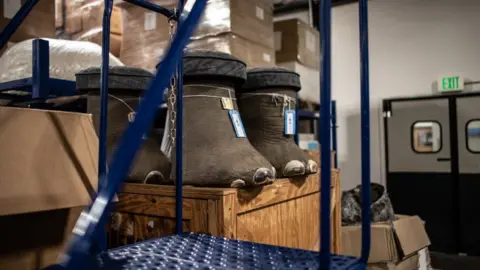 BBC
BBC
The global wildlife trade is the number one cause of animal extinction, tied only with land development.
In October, a study by US and UK scientists revealed that at least one in five vertebrate species on Earth are brought and sold on the wildlife market.
And Interpol estimates the global wildlife trade to be worth up to $20bn (£16bn) a year.
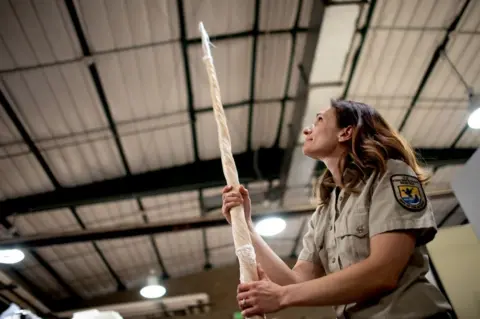 BBC
BBC
With just seven people on staff, the resources are mainly used by government officials, wildlife specialists, conservationists and educators.
Only a small part of the facility is open to members of the public and that is on specific days and by pre-arranged appointment.
The repository used to be part of the US Fish and Wildlife Service's national forensics laboratory, but in the 1990s it became clear that the collection needed its own space and so this site was found and cleared.
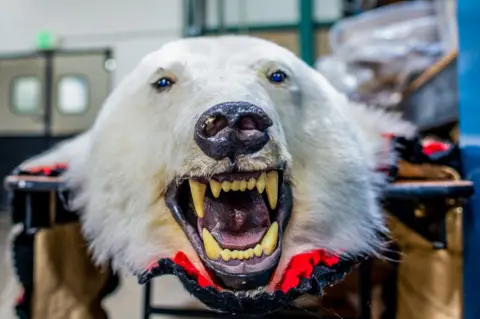 BBC
BBC
"Universities, zoos, aquariums, nature centres, museums - all the different entities that are doing environmental education or conservation work might be able to have access to some of this material for their educational or scientific research."
It's not just animals and flora and fauna imported from overseas that is collected by the repository. It has a whole section dedicated to North American animals and creatures seized when they are trafficked across states illegally.
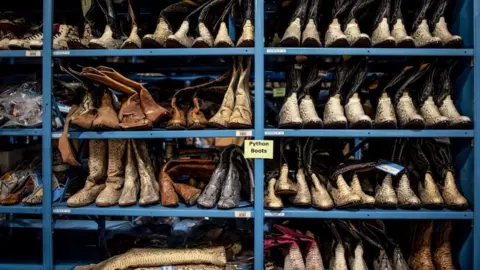 BBC
BBCMs Metzer adds: "What you see here is only the small tip of the iceberg when it comes to what is actually seized and confiscated at these ports of entry or during criminal investigations. We are very specific in what we take because we want to be able to represent particular species that are being used in the [illegal] wildlife trade."
Outside the confines of the warehouse, the definition of what is classed as an endangered species in the US is now a highly contested subject.
Last month US President Donald Trump's administration announced plans for a major overhaul to the Endangered Species Act. This currently protects over 1,600 species in the US and territories.
The changes would eliminate automatic protections for threatened plant and animal species, and make it easier for species to be removed from the list. Independent conservation groups have criticised the move.
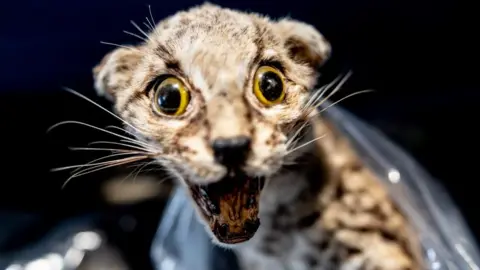 BBC
BBCThere are a lot of dead big cats located in the warehouse, all in a variety of poses. That's because big cat skins and parts are always valuable educational tools.
"We use them to intentionally highlight certain species and raise awareness of those that are very, very threatened," says Ms Metzer.
All of the items that turn up at the repository are in the same condition in which they were seized.
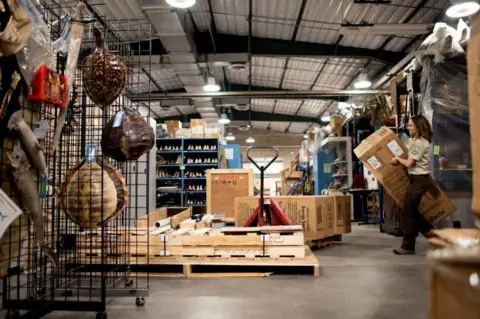 BBC
BBC
"We're not altering them in any way. If it was seized as a rug, a trinket or a raw material, that is how it will come to us," she says.
They're not just macabre items, she says, but have an important effect.
"When you have visitors or school groups that are able to connect with these objects, you really recognise the power that they have in reducing demand for these. You are fostering appreciation, awareness and an understanding the species."
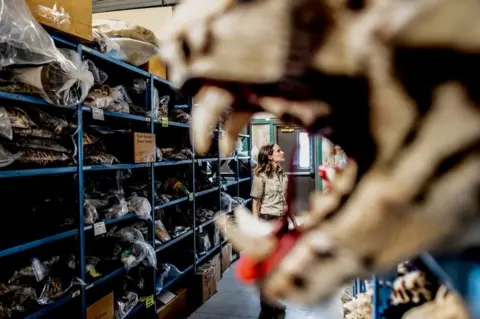 BBC
BBC
The repository has at least 3,000 bear claws in some form or another at the warehouse.
Ms Metzer stresses the building in the Rocky Mountain Arsenal is not a museum: "We are not here to preserve the objects; we are working to get them out and in circulation."
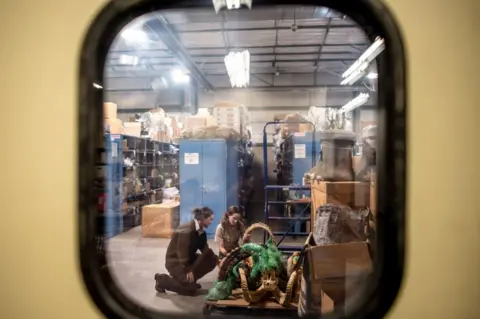 BBC
BBC
The entire facility - which includes the National Eagle Repository - is funded in a unique way as it receives the fines and fees resulting from particular law enforcement investigations.
It can often take years before an item turns up at the repository after it has been confiscated and any criminal investigations it has been involved with are over.
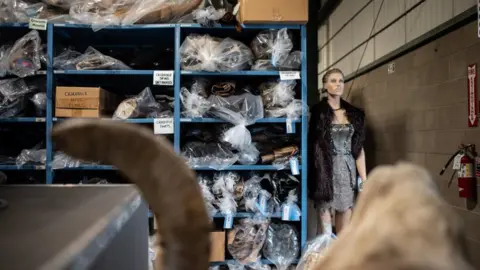 BBC
BBCOccasionally the repository gets inquiries from members of the public who want to donate items discovered during house clean-outs.
"There are younger generations who don't have the same value systems as older generations," says Ms Metzer. "The objects don't have the same intrinsic worth for them or cultural ties and so they try to dispose of it in a responsible way - in a way that makes sure it won't return to the commercial market."
 BBC
BBCThe repository is attempting to work with partner organisations to come up with different ways of educating the public about the wildlife trade.
"When people think of wildlife, most people only think of animals but we are seeing cases involving cacti species being poached, ginseng and so much more," she says. "We don't have live plants here because we aren't designed to hold live specimens but if we come across items, we do catalogue them."
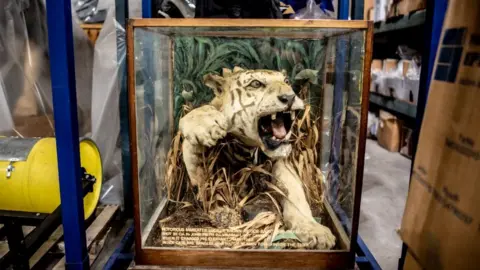 BBC
BBCLeaving the isolated site, some bison and deer stare hard at our car rumbling through the wildlife refuge.
Yet, unlike the menagerie behind the walls of the repository, they stay deathly still for just a few seconds before wandering away back amongst their natural habitat.
Photography by Hannah Long-Higgins
